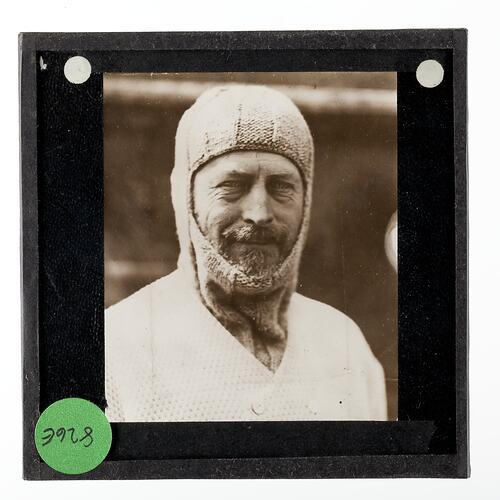Sir Douglas Mawson is one of Australia's best known Antarctic explorers. His personal Antarctic achievements include discovering the location of the south magnetic pole as part of Shackleton's Nimrod Expedition, and organizing and leading the first true scientific expedition to Antarctica. Just as crucially Mawson was instrumental in the establishment of ANARE through his lobbying of the Australian government to continue Antarctic research and exploration after the Second World War. Mawson is honoured today through the naming of the Australian Antarctic research station Mawson, the first permanent base in Antarctica as well as many place names in his home state of South Australia. Between 1984 and 1996 Mawson also featured on the Australian $100 note.
Douglas Mawson was born in Shipley, Yorkshire, England on 5 May 1882. The Mawson family emigrated to Rooty Hill, New South Wales, Australia in 1884. Douglas graduated from the University of Sydney in 1902 with a Bachelor of Engineering. He then began his career in scientific exploration by taking part in a geological survey of the New Hebrides (Vanuatu), under the British deputy commissioner, Captain E. G. Rason. He then furthered his studies in geology obtaining a Bachelor of Science in 1905. He was then appointed lecturer in mineralogy and petrology in the University of Adelaide.
In November 1907 (Sir) Ernest Shackleton, leader of the British Antarctic Expedition, visited Adelaide and Mawson approached him with a view to making the round trip to Antarctica on the Nimrod. He hoped to see an existing continental ice-cap and to become acquainted with glaciation and its geological consequences.
Mawson was appointed as Physicist for Shackleton's 1907-1909 Antarctic Expedition. During this expedition Mawson was one of the first party, led by Edgeworth David to climb Mount Erebus and with David and A. F. Mackay was the first to reach the vicinity of the South Magnetic Pole. David later said: 'Mawson was the real leader who was the soul of our expedition to the Magnetic Pole. We really have in him an Australian Nansen, of infinite resource, splendid physique, astonishing indifference to frost'.
Mawson's next venture to Antarctica was as leader of the Australasian Antarctic Expedition from 1911-1914. There were three bases for the expedition: one at Macquarie Island which was used for scientific work and as a radio relay station; Main Base under Mawson at Commonwealth Bay; and Western Base on the Shackleton Ice Shelf under Frank Wild. Expeditions and scientific investigations were carried out from each base.
In November 1912 Mawson, Ninnis and Mertz set out to survey King George V Land. Unfortunately 310 miles (499 km) into the trip Ninnis, with sledge and dog team, fell into a crevasse and disappeared. Mawson and Mertz turned back immediately, although with limited provisions they were forced to use their dogs to supplement their food supply. The physical exertion, starvation, and potential toxicity of high levels of Vitamin A found in the dog's livers saw Mertz pass away. Mawson, himself seriously debilitated, discarded everything that was not essential for survival, except his geological specimens and records of the journey. Using a pocket saw, he cut his sledge in half and dragged it unaided the last 100 miles (161 km) of the journey, taking another thirty days to reach Main Base. As he approached he saw the Aurora departing, although a small party had remained to search for him. Mawson and this party remained at Main Base for another year continuing their scientific work until December 1913 when a ship came to collect them.
On his return to Australia Mawson wrote his account of the expedition The Home of the Blizzard which was published in 1915 and was illustrated with the photographs of Frank Hurley. Along with other scientists he also began the work of analysing and reporting on the data collected during the expedition; but so great was the task that publication of the A.A.E. Scientific Reports, in twenty-two volumes edited by Mawson, was not completed until 1947.
In 1914 Mawson was knighted and married Francisca Adriana (Paquita) Delprat at Holy Trinity Church, Balaclava, Melbourne. The couple later had two daughters. During WWI Mawson worked with the British Ministry of Munitions. Following the war he returned to the University of Adelaide where he was appointed professor of geology and mineralogy in 1921. In 1920 he was appointed O.B.E.
Mawson was invited to organize and lead the British, Australian and New Zealand Antarctic Research Expedition of 1929-30 and 1930-31. This expedition used the ship Discovery and made extensive geological and biological investigations at Iles Crozet, Iles Kerguelen, Heard Island and many points along a 1550 mile (2494 km) section of the Antarctic coast. Mawson maintained a lifelong interest in Antarctica serving as a member of the Australian Antarctic Executive Planning Committee and promoting the Australian National Antarctic Research Expeditions following WWII. He passed away at his Brighton home on 14 October 1958.
ReferencesJacka, F. J., 1986, 'Mawson, Sir Douglas (1882-1958)', Australian Dictionary of Biography, National Centre of Biography, Australian National University, viewed 11 October 2023.
More Information
-
Keywords
-
Authors
-
Article types
